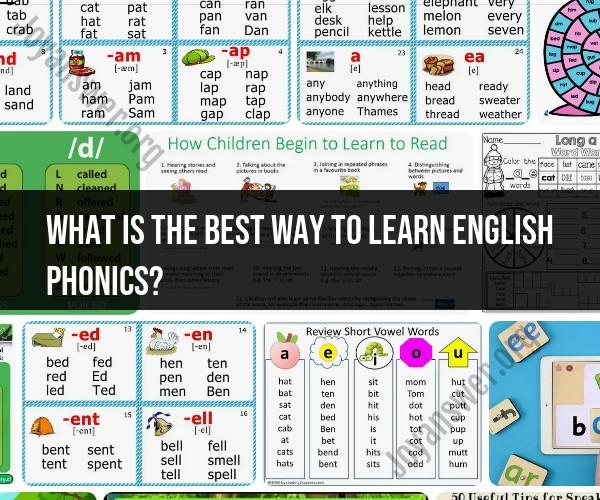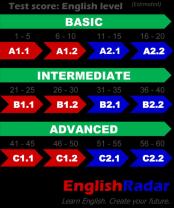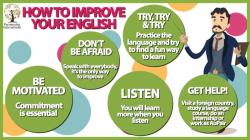What is the best way to learn English phonics?
Learning English phonics, especially for beginners or young learners, is an important step in building strong reading and spelling skills. Here are some best practices for learning English phonics:
Understand the Basics of Phonics:
- Start with the fundamental concept that phonics is about the relationship between sounds and written letters. Explain to learners that each letter or group of letters represents a sound or phoneme.
Phonemic Awareness Activities:
- Begin with phonemic awareness activities that focus on the sounds of language rather than written letters. These can include rhyming games, clapping syllables in words, or identifying the initial sounds in words.
Phoneme Isolation:
- Teach learners to isolate individual phonemes in words. For example, say a word like "cat" and ask them to identify the beginning sound, middle sound, and ending sound.
Phoneme Blending:
- Practice blending phonemes together to form words. For example, say the sounds /c/ - /a/ - /t/ and ask learners to blend them to say the word "cat."
Phoneme Segmentation:
- Encourage learners to segment words into individual phonemes. For example, say the word "dog," and ask them to tell you the individual sounds /d/ - /o/ - /g/.
Phoneme Manipulation:
- Play games that involve changing or substituting phonemes in words. For example, start with the word "cat" and ask learners to change the /c/ to /b/ to make "bat."
Use Visual Aids:
- Utilize visual aids like letter cards or flashcards to represent individual phonemes. These can help learners connect the sounds to the corresponding letters.
Word Families:
- Explore word families (e.g., -at, -og, -it) where the beginning sound is the same, and only the ending sound changes. This helps learners see and hear how phonemes work in different words.
Consistent Practice:
- Be consistent with phonics activities. Short, frequent sessions are often more effective than long, infrequent ones. Make phonics a part of daily routines.
Reading Aloud:
- Read books and stories with learners and point out how the written words correspond to the sounds they've learned. Choose books with simple, phonetically regular words.
Interactive Phonics Apps and Games:
- There are various phonics apps and games designed for interactive learning. These can make the process more engaging for young learners.
Be Patient and Encouraging:
- Phonics can be challenging for beginners, so be patient with their progress and provide positive reinforcement. Celebrate their achievements.
Progress at the Learner's Pace:
- Not all learners progress at the same rate. Adjust the difficulty level and pace of lessons to suit individual needs.
Supportive Learning Environment:
- Create a supportive and encouraging learning environment where learners feel comfortable making mistakes and asking questions.
Learning English phonics is an essential foundation for reading and spelling in the English language. By using a combination of these best practices and tailoring the approach to the learner's age and level, you can help them develop strong phonics skills and a love for reading.
What is the most effective approach to learning English phonics?
The most effective approach to learning English phonics is to use a systematic and explicit approach. This means teaching students the letter-sound relationships in a structured way, and giving them opportunities to practice what they have learned.
Some of the key components of an effective phonics program include:
- Teaching students the letter-sound relationships. This can be done using a variety of methods, such as flashcards, games, and songs.
- Giving students opportunities to practice blending and segmenting words. This can be done through activities such as reading and writing decodable words, and playing rhyming games.
- Teaching students about common phonics patterns. This includes things like long and short vowel sounds, consonant blends, and digraphs.
Are there online resources for learning English phonics?
Yes, there are a number of online resources for learning English phonics. Some popular resources include:
- Starfall: Starfall is a free online resource that provides interactive phonics lessons and games for children of all ages.
- Phonics Hero: Phonics Hero is another free online resource that provides phonics lessons and games for children.
- ABCmouse: ABCmouse is a subscription-based online learning program that includes phonics lessons and games for children.
How can you practice English phonics pronunciation?
There are a number of ways to practice English phonics pronunciation. Here are a few tips:
- Listen to native English speakers. One of the best ways to learn English phonics pronunciation is to listen to native English speakers. You can do this by watching English-language TV shows and movies, listening to English music, or talking to native English speakers.
- Record yourself speaking English. Once you have a good understanding of the letter-sound relationships, you can start recording yourself speaking English. This will help you to identify any areas where you need to improve your pronunciation.
- Get feedback from a native English speaker. If possible, ask a native English speaker to give you feedback on your pronunciation. They can help you to identify any areas where you need to improve.
What are the key phonics rules and patterns in the English language?
Some of the key phonics rules and patterns in the English language include:
- Short vowel sounds: Short vowel sounds are typically made with a short, quick sound. The short vowel sounds in English are: a, e, i, o, and u.
- Long vowel sounds: Long vowel sounds are typically made with a long, drawn-out sound. The long vowel sounds in English are: a, e, i, o, and u.
- Consonant blends: Consonant blends are two or more consonants that are blended together to make a single sound. Some common consonant blends in English are: bl, cl, fl, gl, pl, and spl.
- Digraphs: Digraphs are two letters that together make a single sound. Some common digraphs in English are: sh, ch, ph, and wh.
How can adults and non-native speakers improve their English phonics skills?
Adults and non-native speakers can improve their English phonics skills by following the same tips as children. They should use a systematic and explicit approach to learning the letter-sound relationships, and give themselves opportunities to practice blending and segmenting words. They should also teach themselves about common phonics patterns.
Here are some additional tips for adults and non-native speakers who are learning English phonics:
- Find a phonics program that is designed for adults. There are a number of phonics programs that are specifically designed for adults. These programs can provide you with the support and guidance you need to learn English phonics.
- Take a phonics class. Many community colleges and adult education centers offer phonics classes. These classes can provide you with the opportunity to learn English phonics from a qualified instructor.
- Find a language partner. Practicing English phonics with a language partner is a great way to improve your pronunciation and fluency. You can find language partners online or through local language schools and community centers.
With a little effort, you can learn English phonics and improve your overall English skills.






